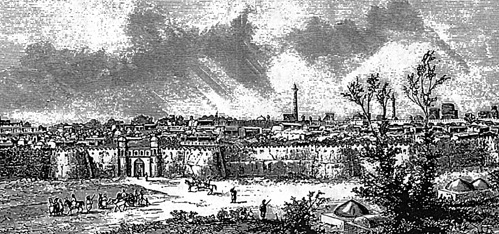196-197
"...we came in sight of the fortress...with its high battlemented walls and buttresses, crooked and irregular, and the water that surrounded it, presented a noble appearance...We halted a few minutes, as some men were seen on the walls; and, in spite of the fortress having already been surrendered, General Kaufmann was not sure that there was not some mischief preparing. The proper dispositions having been taken, the army again moved forward, and entered a long, narrow, covered street, with a single line of houses or shops on each side, which, leading over the water, served as a kind of causeway and entrance to the fortress. We filed through this crooked, irregular street, not without some apprehensions of an ambuscade; and making two or three short turns to the right and left, found ourselves in front of the main entrance.
It was a heavy, massive arched gateway, with flanking towers, built of brick, and plastered over with mud. The gates were pierced in one or two places with holes, evidently made by cannon- balls in some old siege.
"Kaufmann rode in, followed by his staff, and a couple of companies of infantry; made the circuit of the inside of the fortress; and, winding about through several very narrow, crooked streets, at last dismounted in a small court. Entering by a sucession of small, dark corridors and rooms, we found ourselves in the principle court of the palace of Hazar-Asp...
"Thus Hazar-Asp, really a stronger place than Khiva, surrendered without striking a blow. Most of the officers, and the Grand Duke especially, were dissatisfied with this result, but they consoled themselves with the hope that a desperate resistance would be made at Khiva."
198
Hazar-Asp was surrounded by a "shallow pond, and is about ten miles from the river, and forty from Khiva...Five or six cannon were found...together with a number of falconettes, and a large quantity of very good powder, which was left lying around in a very careless manner...Kaufmann left a small garrison here...His intention was to wait for the whole detachment to come up before making the final attack on Khiva."
202
"Although the campaign against Khiva was not decided upon in St. Petersburg until towards the end of December, General Kaufmann had really been two years preparing for it; and when he went to St. Petersburg to obtain permission of the Emperor to attack the Khanate, everything was ready in Turkestan for the instant opening of the campaign...And as the difficulties of the campaign were considered very great, nobody being able to say to a certainty which route offered the most chance of success, the Emperor decided to send four expeditions. in order to insure against failure.
One was to start from the Caucasus, under Colonel Markosoff; another from Orenburg, the direction of which was to be left to General Krysanovsky, the governor of the department, who confided the expedition to General Verevkin; one from Kinderly Bay, under Colonel Lamakin; as well as the one from Turkistan, prepared by General Kaufmann himself."

More Part 2: Russia in Asia
-
Kaufmann and Supplies
Surrender of Hazar-Asp Fortress
Col. Markosoff's Expedition
Gen. Verevkin's March to the Capital
Fort Siting
Large Map of Khiva area (slow: 158K)
Part 1: Russia in Asia (in Heliograph #102)
Back to The Heliograph #103 Table of Contents
Back to The Heliograph List of Issues
Back to Master Magazine List
© Copyright 1997 by Richard Brooks.
This article appears in MagWeb (Magazine Web) on the Internet World Wide Web.
Other military history articles and gaming articles are available at http://www.magweb.com